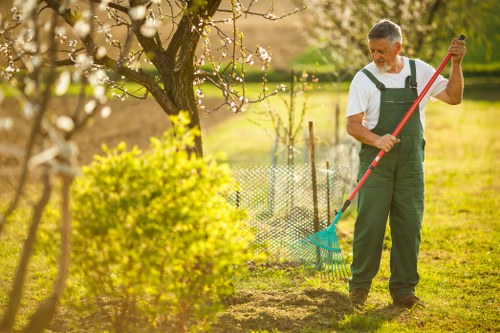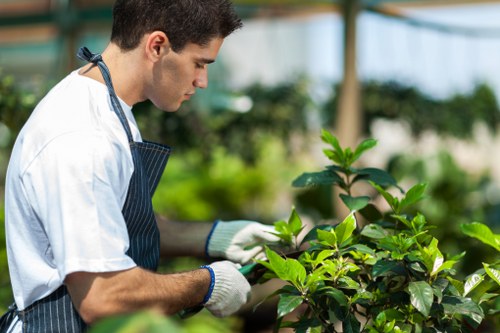Tree Lopping and Removal in Garden Landscape Gardeners

Understanding Tree Lopping and Removal
Tree lopping and removal are essential services in garden landscaping, ensuring the safety, health, and aesthetics of your outdoor space. Whether dealing with overgrown branches or hazardous trees, professional gardeners provide solutions that enhance your garden's beauty and functionality.
Tree lopping involves trimming and cutting back branches to maintain the tree's shape and health. On the other hand, tree removal is the process of completely eliminating a tree that poses a risk or is no longer viable.
Both services require expertise and the right equipment to perform safely and effectively. Understanding when and why to opt for lopping or removal can save you time, money, and potential hazards.

The Importance of Professional Tree Services
Hiring professional garden landscapers for tree lopping and removal ensures that the job is done correctly. Experts have the necessary skills to assess the situation, determine the best course of action, and execute it without causing damage to your property or the remaining trees.
Moreover, professionals adhere to safety standards and regulations, minimizing the risk of accidents. They also provide valuable advice on tree care, helping you maintain a healthy and vibrant garden.
Investing in professional services can extend the lifespan of your trees, improve the overall look of your garden, and increase property value.

Benefits of Tree Lopping
Tree lopping offers numerous advantages for garden maintenance and safety:
- Enhanced Safety: Removing dead or weak branches reduces the risk of them falling and causing injury or property damage.
- Improved Health: Trimming diseased or damaged branches promotes the overall health of the tree.
- Better Aesthetics: Properly lopped trees maintain a pleasing shape and complement your garden's design.
- Increased Sunlight: Removing excess foliage allows more sunlight to reach other plants, fostering growth.
These benefits contribute to a safer, healthier, and more beautiful garden environment.

When to Consider Tree Removal
While tree lopping is beneficial, there are situations where tree removal becomes necessary:
- Hazardous Trees: Trees that are structurally unsound or have significant pest infestations may need to be removed to prevent accidents.
- Space Constraints: Trees encroaching on structures, power lines, or obstructing pathways may require removal.
- Diseased Trees: Trees with severe diseases that cannot be cured might pose a risk to surrounding plants and require removal.
- Development Projects: When redesigning your garden or constructing new features, certain trees may need to be removed to accommodate changes.
Assessing the need for removal should be done by professionals to ensure it's the best course of action.

The Tree Removal Process
Tree removal is a complex process that involves several steps to ensure it's done safely and effectively:
- Assessment: A professional evaluates the tree's condition, location, and any potential risks.
- Planning: Developing a strategy that outlines the removal process, including safety measures and equipment needed.
- Execution: Carefully cutting down the tree, section by section, using specialized tools and techniques.
- Clean-Up: Removing all debris and ensuring the area is left clean and safe.
Each step requires expertise to minimize impact on your property and ensure the safety of everyone involved.
Choosing the Right Tree Service Provider
Selecting a reliable tree lopping and removal service is crucial for achieving the desired results. Here are some factors to consider:
- Experience: Look for companies with a proven track record and extensive experience in tree services.
- Licensing and Insurance: Ensure the provider is licensed and insured to protect against any potential damages or accidents.
- Reputation: Check reviews and ask for references to gauge customer satisfaction.
- Services Offered: Choose a provider that offers a comprehensive range of services, including lopping, removal, and maintenance.
- Pricing: Obtain quotes from multiple providers to compare pricing and ensure you’re getting fair value.
Taking these factors into account will help you select a trustworthy and competent service provider for your tree needs.
Environmental Considerations
Tree lopping and removal can have significant environmental impacts. It's essential to approach these tasks with sustainability in mind:
- Tree Health: Regular maintenance ensures trees remain healthy, contributing to air quality and providing habitat for wildlife.
- Waste Management: Proper disposal of tree debris minimizes environmental footprint. Many services offer recycling options for wood and green waste.
- Preservation: Whenever possible, preserve trees by addressing issues early through lopping rather than opting for removal.
- Replanting: Planting new trees can offset those that are removed, maintaining ecological balance.
Considering these factors helps maintain the environmental integrity of your garden and surrounding areas.
Cost Factors in Tree Lopping and Removal
The cost of tree lopping and removal can vary based on several factors:
- Tree Size: Larger trees require more time and equipment, increasing the overall cost.
- Location: Trees situated in hard-to-reach areas or close to structures may necessitate specialized techniques, affecting pricing.
- Condition: Diseased or damaged trees might require additional safety measures during removal.
- Accessibility: Easier access typically reduces labor time and costs.
- Additional Services: Services like stump grinding or debris removal can add to the total expense.
Understanding these factors can help you budget accordingly and avoid unexpected expenses.
Safety Measures in Tree Services
Safety is paramount in tree lopping and removal. Professionals adhere to strict safety protocols to protect themselves, your property, and the surrounding environment:
- Personal Protective Equipment (PPE): Workers use helmets, gloves, eye protection, and harnesses to prevent injuries.
- Proper Training: Certified arborists are trained in safe tree cutting techniques and emergency procedures.
- Equipment Maintenance: Regularly maintained tools and machinery reduce the risk of malfunctions and accidents.
- Risk Assessment: Identifying potential hazards beforehand ensures that appropriate precautions are taken.
- Weather Conditions: Operations are planned considering weather to avoid dangerous situations caused by high winds or storms.
These measures ensure that tree services are conducted efficiently and safely.
Tree Health and Maintenance
Maintaining the health of your trees is crucial for their longevity and the overall beauty of your garden. Regular maintenance practices include:
- Pruning: Removing dead or diseased branches to promote healthy growth.
- Watering: Ensuring trees receive adequate water, especially during dry periods.
- Fertilizing: Providing necessary nutrients to support growth and resilience.
- Pest Control: Monitoring and managing pests to prevent infestations that can harm tree health.
- Soil Management: Maintaining proper soil conditions to support tree roots and overall stability.
Implementing these maintenance practices helps in sustaining healthy and vibrant trees.
Legal and Regulatory Aspects
Tree lopping and removal may be subject to local regulations and permits. It’s important to be aware of the legal requirements in your area:
- Permits: Some jurisdictions require permits for tree removal, especially for protected or heritage trees.
- Zoning Laws: Regulations may dictate the types of trees that can be planted or removed in specific areas.
- Property Boundaries: Ensuring that tree work does not encroach on neighboring properties or public spaces.
- Environmental Protection: Compliance with environmental laws that protect certain tree species and habitats.
Working with a professional service can help navigate these legalities, ensuring all necessary permissions are obtained.
Innovative Techniques in Tree Services
The field of tree lopping and removal has advanced with innovative techniques that improve efficiency and safety:
- Climbing Equipment: Modern climbing gear allows arborists to access difficult branches safely.
- Crane Assistance: For large or awkwardly placed trees, cranes help in lifting and removing sections without damaging surrounding areas.
- Stump Grinding: Advanced machines can quickly and effectively remove tree stumps, integrating the area seamlessly into your garden.
- Tree Preservation Techniques: Methods like bracing and cabling support weak branches, extending the tree's life without removal.
- Remote Sensing: Technology like drones and laser scanning assists in accurately assessing tree health and planning removal strategies.
These innovations contribute to more effective and environmentally friendly tree services.
Environmental Impact of Tree Removal
While sometimes necessary, tree removal can impact the environment. It’s essential to consider these effects and mitigate them where possible:
- Carbon Sequestration: Trees absorb carbon dioxide, so their removal reduces this benefit.
- Biodiversity: Trees provide habitats for various species; removing them can disrupt local ecosystems.
- Soil Erosion: Tree roots help stabilize the soil; without them, erosion can become a problem.
- Heat Island Effect: Trees provide cooling through shade and transpiration; their removal can increase local temperatures.
Balancing the need for tree removal with environmental considerations is crucial for sustainable garden landscaping.
Replanting and Restoration
After tree removal, replanting is an opportunity to enhance your garden's diversity and resilience:
- Choosing the Right Species: Select trees that are suitable for your climate, soil, and garden design.
- Diversity: Planting a variety of tree species increases biodiversity and reduces the risk of disease outbreaks.
- Placement: Strategic planting ensures trees have enough space to grow without interfering with structures or utilities.
- Maintenance Plan: Implementing a plan ensures newly planted trees receive the care they need to thrive.
Replanting contributes to the sustainability and beauty of your garden, creating a balanced and healthy landscape.
Conclusion
Tree lopping and removal are critical components of garden landscaping that contribute to safety, aesthetics, and environmental health. By understanding the differences between lopping and removal, recognizing when each is necessary, and choosing the right professionals, you can maintain a beautiful and safe garden space.
Remember to consider environmental impacts, adhere to legal regulations, and embrace innovative techniques to ensure your garden remains vibrant and sustainable for years to come.
Contact us today to schedule your tree service and transform your garden landscape!



